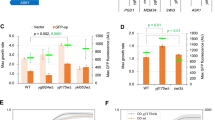Abstract
We performed detailed phenotypic analysis of theisw2Δ strains of the W303 genetic background and compared its results with those obtained previously in BY-derived genetic background. Shmoolike morphology was observed in theisw2Δ strain of α-mating type of the BY strains, but not in its W303-derived counterpart. On the other hand, derepression ofa-specific genes in theisw2Δ (MATα) strain was observed in both genetic backgrounds, although to a different extent. Unlike in BY-derived strain hyperactivation of the Ras2/cAMP pathway reduced invasiveness of theisw2Δ strain (MATα) of the W303 background. Sensitivity to Calcofluor White indicating a cell wall-integrity defect was significantly increased in theisw2Δ strains of the W303 background in contrast to BY-derived strains. Our data indicate that the effects of theisw2 deletion strongly depend on the background in which the deletion is made.
Similar content being viewed by others
References
Aalfs J.D., Kingston R.E.: What does chromatin remodeling mean?Trends Biol.Sci.25, 548–555 (2000).
Brachmann C.B., Davies A., Cost G.J., Caputo E., Li J., Hieter P., Boeke J.D.: Designer deletion strains derived fromSaccharomyces cerevisiae S288c: a useful set of strains and plasmids for PCR-mediated gene disruption and other applications.Yeast14, 115–132 (1998).
Fazzio T.G., Kooperberg C., Goldmark J.G., Neal C., Basom R., Delrow J., Tsukiyama T.: Widespread collaboration of Isw2 and Sin3-Rpd3 chromatin remodeling complexes in transcriptional repression.Mol.Cell.Biol.21, 6450–6460 (2001).
Gimeno C.J., Ljungdahl P.O., Styles C.A., Fink G.R.: Unipolar cell divisions in the yeastS. cerevisiae lead to filamentous growth: regulation by starvation and RAS.Cell68, 1077–1090 (1992).
Goldmark J.P., Fazzio T.G., Estep P.W., Church G.M., Tsukiyama T.: The Isw2 chromatin-remodeling complex represses early meiotic genes upon recruitment by Ume6p.Cell103, 423–433 (2000).
de Groot P.W.J., Ruiz C., Vazquez de Aldana C.R., Dueñas E., Cid V.J., Rey F., del Rodriguez-Peña J.M., Perez P., Andel A., Caubin J., Arroyo J., Garcia Cortes J.C., Gil C., Molina M., Garcia L.J., Nombela C., Klis F.: A genomic approach for the identification and classification of genes involved in cell-wall formation and its regulation inSaccharomyces cerevisiae.Comp.Funct.Genomics2, 124–142 (2001).
de Jesus Ferreira M.C., Bao X., Laize V., Hohmann S.: Transposon mutagenesis reveals novel loci affecting tolerance to salt stress and growth at low temperature.Curr.Genet.40, 27–39 (2001).
Kent N.A., Karabetsou N., Polotis P.K., Mellor J.:In vivo chromatin remodeling by yeast ISWI homologs Isw1p and Isw2p.Genes Develop.15, 619–626 (2001).
Kucharzcyk R., Gromadka R., Migdalski A., Slonimski P.P., Ryika J.: Disruption of six novel yeast genes located on chromosome II reveals one gene essential for vegetative growth and two required for sporulation and conferring hypersensitivity to various chemicals.Yeast15, 987–1000 (1999).
Liu H., Styles C.A., Fink G.R.:Saccharomyces cerevisiae S288c has a mutation inFLO8, a gene required for filamentous growth.Genetics144, 967–978 (1996).
Lo W., Dranginis A.M.: The cell surface flocculin Flo11 is required for pseudehyphae formation and invasion bySaccharomyces cerevisiae.Mol.Biol.Cell.9, 161–171 (1998).
Lussier M., White A.M., Sheraton J., di Paolo T., Treadwell J., Southard S.B., Horenstein C.I., Chen-Weiner J., Ram A.F., Kapteyn J.C., Roemer T.W., Wo D.H., Bondoc D.C., Hall J., Zhong W.W., Sdicu A.M., Davies J., Klis F.M., Robbins P.W., Bussey H.: Large scale identification of genes involved in cell surface biosynthesis and architecture inSaccharomyces cerevisiae.Genetics147, 435–450 (1997).
Peterson C.L.: ATP-dependent chromatin remodeling: going mobile.FEBS Lett.476, 68–72 (2000).
Pichová A., Vondráková D., Breitenbach M.: Mutants in theSaccharomyces cerevisiae RAS2 gene influence life span, cytoskeleton, and regulation of mitosis.Can.J.Microbiol.43, 774–781 (1997).
Roberts R.L., Fink G.R.: Elements of a single MAP kinase cascade inSaccharomyces cerevisiae mediate two developmental programs in the same cell type: mating and invasive growth.Genes Develop.8, 2974–2985 (1994).
Ruiz C., Escribano V., Morgado E., Molina M., Mazon M.J.: Cell-type-dependent repression of yeast a-specific genes requires Itc1p, a subunit of the Isw2p-Itc1p chromatin remodeling complex.Microbiology149, 341–351 (2003).
Schoch C.L., Bruning A.R., Enhan K.D., Pretorius G.H., Prior B.A.: ASaccharomyces cerevisiae mutant defective in the kine-sin-like protein Kar3 is sensitive to NaCl-stress.Curr.Genet.32, 315–322 (1997).
Stanhill A., Schick N., Engelberg D.: The yeast Ras/cyclic AMP pathway induces invasive growth by suppressing the cellular stress response.Mol.Cell.Biol.19, 7529–7538 (1999).
Sugiyama M., Nikawa J.: TheSaccharomyces cerevisiae Isw2p-Itc1p complex repressesINOI expression and maintains cell morphology.J.Bacteriol.183, 4985–4993 (2001).
Trachtulcová P., Janatová I., Kohlwein S.D., Hašek J.:Saccharomyces cerevisiae geneISW2 encodes a microtubule-interacting protein required for pre-meiotic DNA replication.Yeast16, 35–47 (2000).
Trachtulcova P., Frydlova I., Janatová I., Hašek J.: The absence of the Isw2p-Itc1p chromatin-remodeling complex induces mating-type specific and Flo11p-independent invasive growth ofSaccharomyces cerevisiae. Yeast, in press (2004).
Tsukiyama T., Palmer J., Landel C.C., Shiloach J., Wu C.: Characterization of the imitation switch subfamily of ATP-dependent chromatin-remodeling factors inSaccharomyces cerevisiae.Genes Develop.13, 686–697 (1999).
Author information
Authors and Affiliations
Corresponding author
Additional information
This work was supported by grant A502 0102 of theGrant Agency of the Academy of Sciences of the Czech Republic and by theInstitutional Research Concept no. AV 0Z 502 0903.
Rights and permissions
About this article
Cite this article
Trachtulcová, P., Frýdlová, I., Janatová, I. et al. The W303 genetic background affects theisw2Δ mutant phenotype inSaccharomyces cerevisiae . Folia Microbiol 48, 745–753 (2003). https://doi.org/10.1007/BF02931508
Received:
Revised:
Issue Date:
DOI: https://doi.org/10.1007/BF02931508




